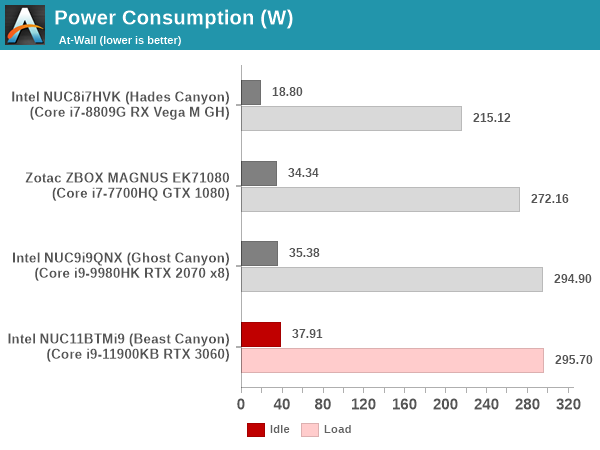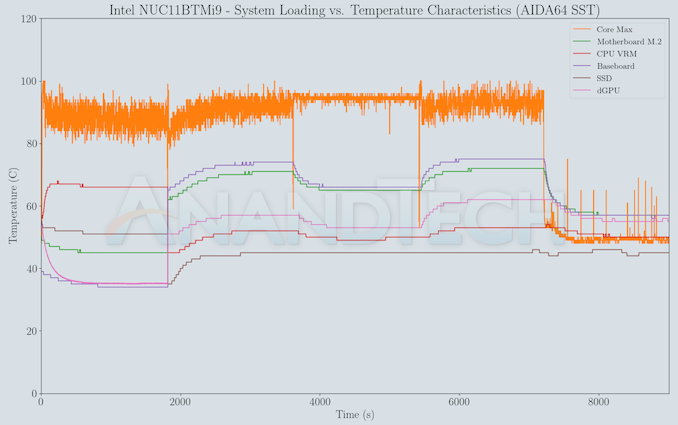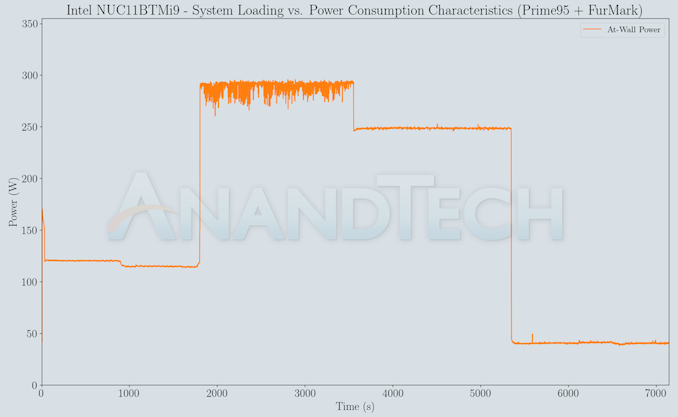Intel Beast Canyon NUC Review: Desktop Tiger Lake Debuts in SFF Gaming Powerhouse
by Ganesh T S on July 29, 2021 9:00 AM EST- Posted in
- Systems
- Intel
- NUC
- Tiger Lake
- NUC11
- Beast Canyon
Power Consumption and Thermal Performance
The power consumption at the wall was measured with a 4K display being driven through the HDMI port of the discrete GPU. In the graphs below, we compare the idle and load power of the Intel NUC11BTMi9 (Beast Canyon) with other similar PCs evaluated before. For load power consumption, we ran the AIDA64 System Stability Test with various stress components, as well as the artificial power virus test involving Prime95 and Furmark. The maximum sustained power consumption at the wall was recorded.

The numbers are very similar to the ones obtained for the Ghost Canyon NUC.
Our thermal stress routine starts with the system at idle, followed by four stages of different system loading profiles using the AIDA64 System Stability Test (each of 30 minutes duration). In the first stage, we stress the CPU, caches and RAM. In the second stage, we add the GPU to the above list. In the third stage, we stress the GPU standalone. In the final stage, we stress all the system components (including the disks). Beyond this, we leave the unit idle in order to determine how quickly the various temperatures in the system can come back to normal idling range. The various temperatures and power consumption number for the system during the above routine are presented in the graphs below.
While the CPU package manages to stay below the junction temperature during the system stability test, it does hover very close to the limits. This is likely due to the fans not taking effect soon enough, as the BIOS tries to maintain a balance between noise levels and cooling efficiency. It is likely that the production BIOS will need to sacrifice some noise levels for better thermals. Despite significant loading on the SSD, the thermal solution is good enough to keep the temperature below 75C.
A similar test routine is conducted with Prime95 running in maximum power consumption mode for 30 minutes, followed by the addition of a FurMark stress workload for another 30 minutes. After a cumulative run time of a hour, the Prime95 workload is removed, and FurMark allowed to proceed for another 30 minutes. The system is then left idle for another half an hour. The metrics tracked in the AIDA64 SST case are also tracked here.
The artificial power virus test significantly amps up the power consumption when both Prime95 and Furmark are simultaneously active. The GPU temperature is also a bit toasty and seems to suffer some after-effects of the Furmark loading. However, the core temperature quickly falls down to around 50C, thanks to the well-ventilated chassis and the three fans on the top panel.














84 Comments
View All Comments
sorten - Thursday, July 29, 2021 - link
"It's really a shame that AMD doesn't have something like this"They do. Pick one of the dozens of SFF cases on the market and build (or buy) it yourself. The only thing you'll be missing is the soldered CPU preventing an easy upgrade.
n0x1ous - Thursday, July 29, 2021 - link
would have been nice to see the Razer Tomahawk Ghost Canyon NUC compared to thisrepoman27 - Thursday, July 29, 2021 - link
A couple minor nits..."The slot to the right of the processor is enabled by the x4 Gen 4 lanes directly from the processor, while the two to the right (and the M.2 slot occupied by the WLAN card) are from the PCH."
One of those rights is wrong.
"They can operate in Thunderbolt 4 (40Gbps), native USB 4 (10Gbps), and native DP1.4 modes."
That should be: "They can operate in Thunderbolt 4 / USB4 (40 Gbps), native USB3 (10 Gbps), and native DisplayPort 1.4 (8.1 Gbps, DSC 1.1 supported) modes."
repoman27 - Thursday, July 29, 2021 - link
Dang it, DP is 4 lanes so my correction requires correction.That should be: "They can operate in Thunderbolt 4 / USB4 (40 Gbps), native USB3 (10 Gbps), and native DisplayPort 1.4 (32.4 Gbps, DSC 1.1 supported) modes."
mcnabney - Thursday, July 29, 2021 - link
Would have liked to see the metrics also include a regular non-SFF build which included similar parts (CPU/GPU/RAM/NVME) to contrast what is being given up for the size shrink.Calin - Friday, July 30, 2021 - link
Just to see how much a power dissipation of 200W instead of 100W would help a 65W processor.mode_13h - Monday, August 2, 2021 - link
Yeah, a Rocket Lake i9 would've been an interesting comparison. I think TomsHardware tried that, if you want to look it up.Timoo - Thursday, July 29, 2021 - link
Wasn't Intel that company that locked-in their vendors, to make sure that suprerior competitors didn't get a chance?For which they had to pay petty-handouts in lawsuits (like: singular billions), because the real/justicial world wasn't used to the profits made by their criminal behaviour?
5j3rul3 - Thursday, July 29, 2021 - link
Like to see the comprasion between the NUC11i9 with R7 5800X, i9 11900K, i9 10900K, 5800U, 5980HS, 1165G7, 11980HK and Apple M1.8 Cores the Great🤣
I am also curious about the Perf. of Xe Graphic in the i9 10900KB
But it seems the i9 10900KB is the
better i9 for intel DT user.
hubick - Thursday, July 29, 2021 - link
I've owned two Skull Canyon NUC's, two Hades Canyon, and a Ghost Canyon NUC 9 Pro. I love the expandability of the card slot in the Ghost Canyon NUC 9 Pro, but I think Beast Canyon has crossed a line where it's just too large for me now. You could still take a Ghost Canyon as carry-on on a flight no problem, or shove it in a backpack for a bike commute - but this just is just so chunky and boxy, it looks too much like something that belongs on a desk.Can I buy the new compute element card and put it in a Ghost Canyon case?
Will there be an updated Xeon compute element? I'm running mine as a NAS box with a ZFS drive array connected via Thunderbolt, and ZFS wants the ECC RAM.